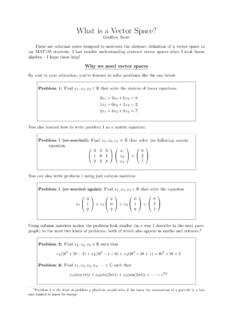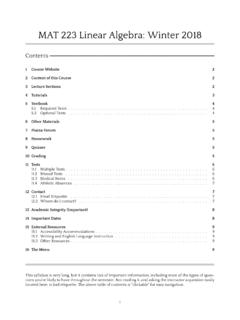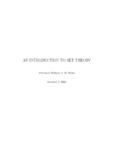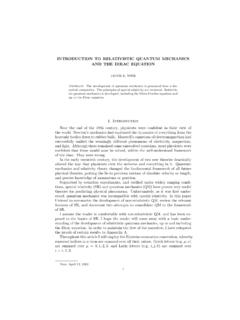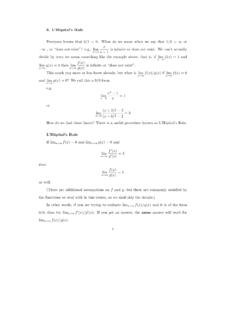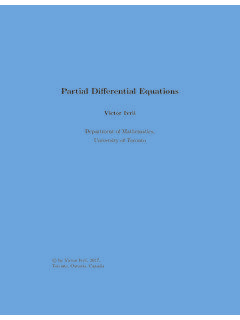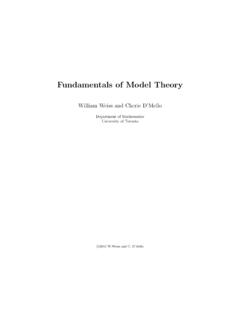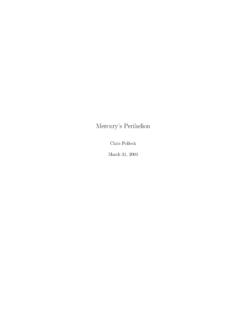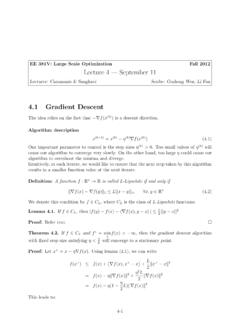Transcription of Mat 1501 lecture notes - » Department of Mathematics
1 Mat 1501 lecture notesweek of September 30-Oct weak convergenceWe say that a sequence ( k) of Radon measures onRnconverges weaklyto alimiting measure if(1) f d k fd for allf Cc(Rn)ask .When this holds, we write k .There are a number of variants of this notion, listed below. However, thedefault definition for us will be that in (1), and we will always try to state clearlywhen we are considering one of the following alternatives. One variant arises if consider sequences such that (1) holds, but withCc(Rn) replaced by the larger spacef C0(Rn).
2 This is a slightly strongernotion of weak convergence , since we ask that (1) hold for a large classof functions, and is applicable to sequences of measures with uniformlybounded total variation. We can also define weak convergence of a sequence of signed measures, byexactlythe same formula (1) as for Radon measures. We can also define weak convergence for vector-valued measures. Forexample, if k= ( 1k,.., mk) is a sequence ofRm-valued measures, then k is F d k F d for allF Cc(Rn,Rm)where F d =m i=1 Fi d i, F= (F1,..,Fm). more generally still, recall that ifYis a separable Banach space, thenwe can think of continuous linear functionals on the spaceCc(Rn,Y) as Y -valued measures onRn.
3 We say that a sequence of linear functionals k Cc(Rn,Y) converges weakly to a limit if k(F) (F) for allF Cc(Rn,Y).When this holds, we will again write k .There is also a closely related notion in which we impose the strongercondition k(F) (F) for allF C0(Rn,Y).Note that every example mentioned above is a special case of the last one(s).Thus we will sometimes state and prove results in the setting ofCc(Rn,Y) , sinceit includes all possible special cases of interest for weak a separable Banach space, and that that kis a sequenceof linear functionals onCc(Rn;Y)such that, for every compactK Rn, there existssomeCKsuch that(2) k(F) CKsupx K F(x) Yfor allF Cc(Rn,Y)with support there exists a subsequencek`and some Cc(Rn,Y) such that(3) k`(F) (F)as` , for everyF Cc(Rn,Y).
4 1. First we claim thatCc(Rn;Y) is separable. To see this, fixdense subsetsD1 YandD2 Cc(Rn), and defineD:={finite sums of the form fi(x)yi, withyi D1andfi D2}.ThenDis countable, and it is not hard to check that it is dense inCc(Rn;Y).Exercise thatDis dense inCc(Rn,Y).(A very similar issue arose in our proof of the representation theorem for ele-ments ofCc(Rn,Y) . There I believe that I just asserted without proof, and withoutasking you to check it, the related fact that was needed.)Step 2. We may assume that the countable dense subsetD Cc(Rn,Y) foundabove is a vector space overQ, since if it is not, then we can replace it by a set,still countable, with this us write the elements ofDasF1,F2.
5 The sequence k(F1),k= 1,2,..is a bounded sequence of real numbers, as aresult of (2), so there is a subsequence of the positive integers, which we can writek1`,`= 1,2,.., such that k1`(F1) a limit, sayL1as` .Repeating this argument and repeatedly passing to subsequences (so that, say,(km+1`) `=1is a a subsequence of (km`) `=1, then finally taking a diagonal subsequence,we can find a subsequence (k`) `=1such that k`(Fi) a limitLias` for can thus define a functionL:D RbyL(Fi) =Lifor everyi. It follows fromthe linearity of the k`and the assumption (2) thatLis linear and that(4)L(Fi) CKsupx K Fi(x) Yif supp(Fi) 3.)
6 Thus,Ldefines a continuous map from a dense subset ofCc(Rn,Y)toR, and so has a unique extension to a continuous map :Cc(Rn,Y) R. ForeveryFi D,lim sup| k`(F) (F)| lim sup(| k`(F Fi)|+| k`(Fi) (Fi)|+| (Fi F)|) lim sup| k`(F Fi)|+| (Fi F)|.SinceDis dense, it follows from this, (2), and (4) that satisfies (3). The theorem may also be proved by simply citing a version of the Banach-Alaoglu Theorem, which in fact is just a more general form of the same result(without any assumption of separability, and requiring some form of the axiom ofchoice in its proof.)
7 1. WEAK other descriptions of weak convergence of Radon return to weak convergence of sequences ofRadon that( k)is a sequence of Radon measures onRn. Then thefollowing are equivalent.(1) k .(2)For every open boundedO Rnand compactK Rn,lim inf k(O) (O),andlim sup k(K) (K).(3)For every bounded Borel setA Rnsuch that ( A) = 0,lim k(A) = (A).Proof.(1) (2): Suppose thatO Rnis open. Then (O) = sup{ fd : 0 f 1,f Cc(O)}.Since for anyfwith support inOand such that 0 f 1, , fd = limk fd k lim infk k(O),the first claim follows by taking the supremum over all suchf.
8 The second claimis proved similarly, starting from the observation that forKcompact, (K) = inf{ fd : 0 f 1,f Cc(Rn),f 1 onK}.(2) (3): If ( A) = 0, then (writingA for the interior ofA) ( A) = (A ) + ( A) = (A ).Also, since (A ) (A) ( A), (and similarly for n) it follows that (A) = ( A) lim sup n( A) lim inf n(A ) (A ) = (A).(3) (1): Assume (3), and fixf Cc(Rn). We want to prove that(5) fd k fd .We may assume thatf 0, since the general case follows that(6)the set{t6= 0 : (f 1{t})>0}is at most countable,since for any countable setCof nonzero real numbers, (supp (f)) ti C (f 1{ti}),whereas, if (6) failed, the sum on the right-hand side above could be made arbi-trarily large by a suitable choice fix >0 and choose 0 =t0< t1<.
9 < tN(for someN) such that(7)|ti ti 1|< and (f 1{ti})= 0 for alli, tN> , letBi:={x Rn:ti< f(x) ti+1}4and definef :=N i= follows from the choice oftiand the continuity offthat ( Bi) = 0 for everyi 1, and hence from (2) that f d k= ti k(Bi) ti (Bi) = f d ask . In addition, the definitions imply that|f f |< 1K, whereKis thesupport off. Thus (f f )d (K)andlim sup (f f )d k lim sup k(K) (K).Since fd k f d (f f )d k + f d k f d + (f f)d it easily follows thatlim sup fd k f d 2 (K)and since is arbitrary, this implies (5).
10 Examples of weak (xk) be a sequence of points k= xk. Thus, f d k=f(xk)forf Cc(Rn).Then it is more or less immediate thatifxk some limitx,then k := xask . Although this is sort of trivial, it illustrates the utility of weak conver-gence. In particular, ifxk xandxk6=x, then it isnotthe case that xk xin certain natural stronger topologies. In particular, under these hypotheses, foreverykwe have xk x C 0= sup{ fd( xk x) :f C0(Rn),supx|f(x)| 1}= sup{f(xk) f(x) :f C0(Rn),supx|f(x)| 1}= 2 Example similarly checks thatifxk ,then k WEAK CONVERGENCE5 Example C c(Rn) be a function with support in the unit ball, andsuch that 0, Rn (x)dx= B1 (x)dx= 1 For >0, define (x) :=1 (x ), :=Ln.
